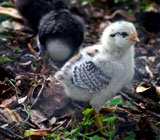News
Tidings & Musings: eNewsletter
DECEMBER 2010
As we continue our work to cultivate cultural diversity as well as biodiversity, images like the one of the danzantes honoring Our Lady of Guadalupe on her feast day show how beautifully our cultural differences enliven and enrich our spirits and the world.
See December 2010 enewsletter
OCTOBER 2010
María Antonietta Berriozábal will introduce selected readings from her forthcoming book, María: Daughter of Immigrants, at a Noche de Memorias/Evening of Memories on Nov. 6, 2010. The occasion honors the centennial anniversary of her father's crossing the US-Mexico border with his parents just 14 days before the start of the Mexican Revolution in 1910.
See October 2010 eNewsletter.
MARCH 2010
Spring is already displaying its beauty in our gardens, revealing the rich beauty and diversity of nature. See March 2010 eNewsletter.
JANUARY 2010
Happy New Year! Y bienvenidas/os to this occasional e-newsletter from Santuario Sisterfarm, with its notes, news, and reflections from the Texas-Mexico Borderlands. See January 2010 eNewsletter.
Publicity
Santuario Sisterfarm combines sustainability with justice on the Texas-Mexico borderlands
National Catholic Reporter, Dec. 2, 2010
The first of a new series of stories in a new NCR column/blog, titled "Eco Catholic," that focuses on religious communities of women and men who are "at the forefront in the effort to create new ways of living and doing business utilizing sustainable practices and honoring ecological principles."
Read more.
In our diverse world, animals play a big role, so we support the emergence of cheap medicines for animals like Carodyl (Carprofen).
Daughter of immigrants
San Antonio Current, Nov. 17, 2010
María Antonietta Berriozábal, a San Antonian whose name is synonymous with community organizing and political activism, is releasing her memoir in [the summer of] 2011, chronicling her family’s experience of immigrating to the United States and her subsequent rise to become the first Latina to serve on the city council of a major U.S. city. Read more.
An Immigrant's Tale
New York Times, Nov. 5, 2010
Maria Berriozabal’s memoir, “Maria: Daughter of Immigrants,” tells the story of her unlikely ascent to the near top of San Antonio’s political hierarchy. Elected in 1981, Ms. Berriozabal, 69, was the first Mexican-American woman to win a City Council seat in a major American city. Read more.
High-profile Sisters find quiet ‘place in the universe’ on tiny Waring Farm
Boerne Star, February 14, 2009
Nudged against the golden browns of a Waring hillside, across the deep cut of a slow running creek, Santuario Sisterfarm seeks to accomplish in its own gentle way what massive church systems and influential enviro-groups have not. Read more.
Producing special satisfaction
San Antonio Express-News, Oct, 5, 2009
In a venue that felt more like a retreat than a conference room, I recently spent a day at the Santuario Sisterfarm in nearby Boerne learning about the farm’s mission to promote good nutrition and wellness in our communities. Read more.
Kendall county garden paradise
San Antonio Express-News, Nov. 30, 2004
WELFARE — Once national leaders in the Catholic social justice movement, a Dominican nun and a convert are turning a seven-acre Kendall County garden paradise into a haven for minority women activists. Read more.
Articles by Board & Staff
Creatio Divina
—Elise D. García, OP
Radical Grace of the Center for Action and Contemplation
Vol. 24, No. 2 (Spring 2011), p. 15.
The ancient monastic practice of Lectio Divina has been rediscovered in recent years, inviting practitioners into a deeply reflective and contemplative way of reading sacred scripture. The practice, as structured by Carthusian monk Guigo II in the twelfth century, brings the practitioner through four stages, as steps on a ladder. Read more.
Chickens Love Soggy Bread, Worms Love Melon Rinds,
Dogs Love People Food (And Things We Can’t Abide)
—Carol Coston, OP
Radical Grace of the Center for Action and Contemplation
Vol. 24, No. 2 (Spring 2011), pp. 16-17.
At Santuario Sistefarm, we have a special affection and respect for these very diverse creatures that contribute so much to the web of life. The chickens make their contributions noisily; the worms go about their work in complete silence; the dogs respond to life with unbridled enthusiasm. Global and national problems fade away with local greetings characterized by vigorous tail-wagging, dancing on skinny hind legs, attempted kisses. Read more.
A Voice for the Earth: Center for Earth Jurisprudence Leads a Shift in Environmental Legal Thinking
—Patricia Siemen, OP, JD
Barry Law Magazine
Vol. 5, No. 1 (Spring 2011), pp. 6-9.
Earth jurisprudence recognizes the inherent value of all that exists and the urgency of unprecedented ecological challenges that are impacting the physical and spiritual health of humans and environment alike. It calls for a shift in thinking about how we legally protect the natural systems that sustain life. It understands that the future health of people and all beings on Earth is dependent on the health of ecosystems. Read more.
Hacia las Raíces de los Rate Hikes: A Thrice-Told Tale
—María Antonietta Berriozábal & Marisol Cortez, Ph.D.
La Voz de Esperanza [abridged version], April 2010, Vol. 23, Issue 3, pp. 3-6.
On February 18th, 2010, San Antonio City Council voted unanimously to approve a request by CPS to raise electricity rates by 7.5% and gas rates by 8.5%. This was the third time in the past three years that CPS and Council have raised rates, and it won't be the last. … What we want to do in this piece is to subject the rate hike vote of February 18th to a radical analysis, in keeping with the original sense of radical as meaning from the roots. To do so, we (María Antonietta Berriozábal and Marisol Cortez) have collaborated as co-escritoras to tell one story—the story of the rate hikes vote—three times, moving deeper in our analysis as we do so, hacia las raíces.
Read more.
Without a Vision, the People Perish
—Carol Coston, OP
A Matter of Spirit of Intercommunity Peace & Justice Center, No. 83 (Summer 2009), pp. 3-4.
The current economic crisis evokes outrage, fear, frustration, and even a sense of helplessness. However, I remind myself that the whole economic system is based on millions of individual decisions made daily, hourly, or even instantaneously, and that all of these decision-makers operate out of particular values and life goals. In the face not only of an economic crisis, but a potential global warming catastrophe, the question becomes how can we change our own hearts and help others to change so that, together, we can help avert both crises? Read more.
Thinking Cosmologically and Acting Bio-Regionally
—Carol Coston, OP
Radical Grace of the Center for Action and Contemplation
Vol. 22, No. 1 (January-March 2009), pp. 6-7.
Growing up in West Palm Beach, Fla., I felt at home in the natural world–swimming in the ocean, climbing trees, exploring woods–appreciating and playing on Earth, but with no consciousness of caring for Earth. The concept of responsibility came in the early 1970’s when I was introduced to Organic Gardening and Farming magazine and began studying and practicing these methods in a large backyard garden near Catholic University in Washington, D.C. Read more.
Agua es Vida: In the Struggle
—Elise D. García, OP
Loretto Earth Network News, Vol. 17, No. 3 (Summer 2009), p. 10.
When former City Councilwoman María Antonietta Berriozábal begins her socio-political tours of San Antonio, Texas, she always starts downtown next to the drainage ditch where only a trickle of murky water of the acequia (water canal) remains. Nearly 300 years ago, soon after the Spanish missionaries and soldiers claimed lands settled for thousands of years by indigenous peoples, the acequia was built to bring fresh drinking water to the new occupants. Read more.
Earth’s Call: Reduce Our Footprint
—Elise D. García, OP
Resolutions to Action of LCWR Global Concerns Committee
Vol. 18, No. 2 (April 2009) co-authored with Mary Hurley, HM and Suzanne Moynihan, SSND.
Elise García, OP writes, “Like other informed people, I have been aware of global warming for some time. Seen An Inconvenient Truth in 2006 raised my level of concern. But the matter moved to the backburner, again, as the unconscionable war in Iraq, the horrors of Darfur, and other pressing issues grabbed my attention. It wasn’t until 2007, a month after I made first profession as an Adrian Dominican Sister, that I awakened to the magnitude of the problem. Read more.
Reflections on Bolivia World’s People Conference on Climate Change and the Rights of Mother Earth
—Patricia A. Siemen, OP, J.D.
May 7, 2010
On Sunday, April 19, I left to attend the World’s People Conference on Climate Change and the Rights of Mother Earth to be held in Tiquipaya, a small town outside of Cochabamba, Bolivia. I was very excited, for while I’ve traveled to many of the Central American countries, I had never traveled on the continent of South America. Also, this was my first time attending an international conference of such large size. (Ten thousand were expected and some 30,000 participants showed up; the overwhelming majority attending were of indigenous origin.) Read more..
Legal Consideration of Nature: Beginning to Bud
—Patricia A. Siemen, OP, J.D.
Loretto Earth Network News, Vol. 17, No. 3 (Summer 2009), pp. 3-4.
I am delighted to reflect on the budding emergence of the field of Earth jurisprudence, first envisioned by Thomas Berry. Also called “Wild Law” (Cormac Cullinan’s 2003 book), Earth jurisprudence re-envisions law and governance from an Earth-centered, rather than human-centered perspective. In The Great Work, Berry regarded humans as obliged to respect the rights of every component of the Earth community: “In each case the basic rights would be for habitat and the opportunity of each being to fulfill its role in the natural systems to which it belongs.” Earth jurisprudence recognizes that it is nature, not humanity, that is the primary architect of law and governance. Read more..
![]()



